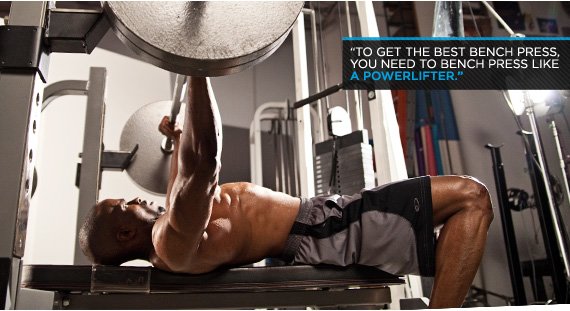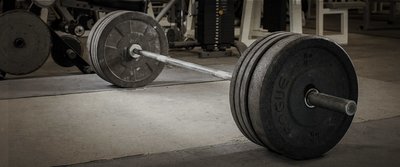Don't get me wrong, a nice set of abs looks great (particularly on a woman). But for most guys, having visible abs usually means that you're skinny. A better illustration of man-muscularity is a powerful chest (which also looks great on a woman!). I find it odd that decent arms are a dime a dozen, but a good set of pectorals is hard to find. This is especially strange since many dudes focus heavily on their chests. My friend Zach was like that, too.
Zach had been training as long as I had. He's the guy who coerced me to compete in my first bodybuilding contest. He had abs, dense arms, a narrow waist, even the coveted diamond-shaped calves. But his chest just sucked. He had been training for 8 years, and his chest could have belonged to a 10-year-old boy.
Even though we had known each other for a long time and our relationship was defined by a shared love of training, we rarely worked out together. I wasn't aware of what Zach did in the gym. He finally came to me for some suggestions. After seeing how he trained his chest, I was not surprised that Zach was failing to progress the way he wanted. We documented several common mistakes that Zach was making. We realized he wasn't taking advantage of a few good techniques.
We put this information into a list of chest training no-nos. You're the damn lucky son-of-a-gun who gets to apply this world-turning information.
1. Overtraining
To the aesthetically minded, there are few things more important than a thick, rounded chest. As a result, many people's routines involve training the chest with a higher volume, frequency or intensity than any other body part. More is not better; BETTER is better. If you don't believe me, ask your girlfriend.
There should be balance in your program. Unless your chest has been neglected and is a legitimate weak spot, giving it top training priority isn't usually appropriate. The pecs primarily draw the upper arm toward the midline of the body (a horizontal pushing motion). Compare the volume of your chest workout to the volume of work you do for the opposite function in the back (horizontal pulls). Most people have as much or more volume for just their pecs as they do their entire back. Can you say unbalanced?

2. Excessive Shoulder Rotation

On Mondays, or "National Chest Training Day," as some people call it, the bench presses and chest machines are typically filled with eager trainees. Because of this bum-rush to the bench press and improper technique, you will likely see a young guy spending more time rubbing his shoulder than under the barbell.
A chest press seems like an easy movement to perform, but there are a few things you need to be aware of if you don't want your shoulders to resemble a log after it's been through a wood-chipper.
When performing any kind of pressing motion for the chest, there is the chance that you will wreck your AC joint and the structures around it. To prevent this, you simply need to reduce the amount of shoulder rotation during the movement. Keep your shoulder blades pinched back (retracted) throughout the entire movement.
The guilty sinners tend to protract their shoulders (round them forward) as they press, not only robbing the pecs of some of their involvement, but also putting the shoulder girdle in a vulnerable position, "pinching" a portion of your rotator cuff that could result in a sharp pain.
3. Too Much Bench Pressing
Unless you are training for maximum strength (particularly powerlifting), there isn't a good reason to focus on bench pressing. To people focused on aesthetics, the bench press is just another chest exercise, and maybe not the greatest.
To get the best bench press, as well as one that protects the shoulder, you need to bench press like a powerlifter: arch your back, drive your heels into the ground, retract your shoulders and draw your elbows in (slightly) to reduce the range of motion and shoulder rotation. While this technique may be ideal for strength training, it will also reduce much of your pec involvement.
Maximum chest recruitment would mean a flat back with the elbows 90 degrees out from the body, touching the bar to your chest or even your neck. However, due to shoulder problems mentioned above, I don't recommend this method. Instead, eliminate the flat barbell presses altogether.

A switch to dumbbells, certain machines, or cables allows the lifter to adopt a slight rotation in the hands, taking the shoulder rotation out of the equation. A switch to a decline or an incline also circumvents this issue to a great degree (there is a reason 6-time Mr. Olympia Dorian Yates doesn't flat bench). While the powerlifter in me cringes to say this, for bodybuilding purposes, it may be helpful to eliminate the flat barbell presses out of your program!
4. Avoiding The Upper Chest

When I started training as a young teenager, most of the materials I found to help me get started came from used bookstores. Most of my resources were fairly old, meaning I was better acquainted with bodybuilders of my parents' generation than my own. One of the books I got was by Franco Columbu, 2-time Mr. Olympia and training partner to Arnold Schwarzenegger. I was fascinated by something he had that was better than any other bodybuilder I had ever seen: a HUGE upper chest. The split between his upper and lower pecs was deeper than the Dead Sea.
Franco did a lot of powerlifting and Olympic lifting, but he also did a ton of incline pressing. Early in his career, the gym he trained at was so crappy it didn't even have a flat bench! So, he and Arnold rigged a set-up that allowed them to do a sort of leaning incline press, and that was pretty much the only chest pressing work they had available. It had an impressive result, so incline presses always had a place in their program.
5. Neglecting Full Range Of Motion
I don't do a lot of isolation movements, but I have started to realize there can be benefits from things like cable crossovers even for a powerlifter. When I was bodybuilding, nothing seemed to set my chest on fire like a crossover. When I made the leap to the dark side and started strongman and powerlifting, I almost entirely cut out isolation movements and focused on heavy compound lifts. In powerlifting, the objective is to reduce the range of motion; that's not the case for bodybuilding. Despite this, I regularly see guys limit their range of motion because they're trying to work weights that are too heavy.
As it turns out, lightweight, full-range-of-motion movement is a great complement to your heavy compound work. Now, don't go spending all your time doing isolation, but rather shift your focus to an area that would be difficult to fully stretch under a barbell. You'll require a lighter load (and a lighter ego); ditch the 100-pound dumbbell flye/press/thingy, grab those 40-pounders, and stretch.
6. Compound First

{{caption}}
The normal chest-enhancing protocol probably looks like this: your obligatory flat barbell presses, followed by an incline or decline hammer strength press, and then finished with a flye. This will work well for most people, most of the time. However, when I get a client who is tall, has narrow shoulders, and long arms, asking about his chest being outpaced by shoulder and arm development, I tend not to go that direction. If you aren't most people, or if you desire chest specialization, the pre-exhaustion technique may be just what the trainer ordered!
If you feel your shoulders and triceps overpowering your chest during your pressing movements, pre-exhaustion may be your counter-move to keep the shoulder-dominance in check. The method involves fatiguing your pecs with an isolation movement prior to your heavy compound moves. Because it's already zapped of energy, the chest should fail earlier than the fresh arms and shoulders assisting in the movement.
I incorporate this method with a standing cable flye. Start with 3-to-4 light sets for a warm-up. You want to avoid going to failure with a heavy weight in a fully-stretched position while the muscle is still cold. Just 2-to-3 sets of 10-to-20 reps with a light weight should suffice before moving to 3 sets of 12-to-15 repetitions of working weight.
I prefer doing three intense sets with adequate rest in between for higher intensity rather than using supersets or short rest breaks to cause fatigue.
7. Focusing On The Positive
This is another area where strength trainers differ from bodybuilders. Heavy, slow negatives aren't usually considered the best thing for maximum strength gain, but they are wonderful for stimulating muscle growth. There is a reason nearly every bodybuilding program out there instructs you to take the eccentric portion of an exercise slowly.
There are two ways to incorporate a negative focus on your training. The first: simply alter the tempo of your movements to extend the duration of your training. If the eccentric (the part of the movement where you lower the weight on your chest press) is less than two seconds in duration, extend it to four. It will require focus to lower the weight this slowly, but the results will change the way you think about training. You can do this type of negative-focused training all the time. The second technique, however, should be used sparingly.

Research has shown us the negative portion of an exercise is responsible for a large amount of the "damage" that occurs when training. This is why certain types of lifts, like the clean or the snatch can be done frequently: They are (relatively) easy to recover from. Heavy negatives however, require significant rest time.
Find a competent spotter, or three! I recommend the safety of a power rack. After taking time to thoroughly warm up, load a barbell press (a shallow incline or decline) to a load greater than you can lift unaided. I suggest an overload of approximately 10%. Unrack the weight, and as slowly as you can, lower the weight to your chest. Have your spotter(s) assist the weight back up before taking one more repetition. A few sets of negatives every now and again can do wonders to bring up a lagging chest.
These statements have not been evaluated by the Food and Drug Administration. This product is not intended to diagnose, treat, cure, or prevent any disease.

